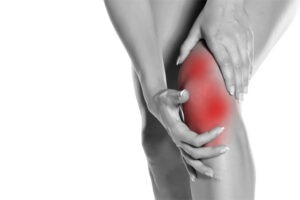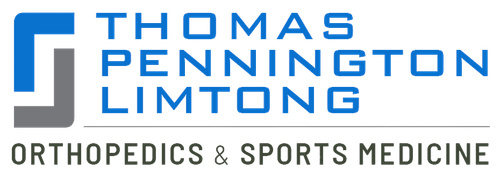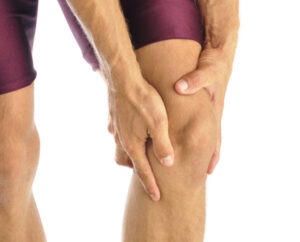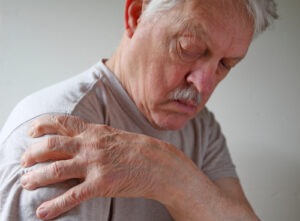 Knee replacement surgery is a major procedure with a long recovery process. As a result, patients who have undergone knee replacement often find themselves wondering when they can return to work. It’s important to consult a knee specialist to determine the best timing for your return to work, as well as the steps involved in the process. In this blog post, we’ll discuss when and how to return to work after knee replacement surgery. At the practice of Steven C. Thomas, MD and Gregory T. Bigler, MD. Our board certified surgeons specialize in knee replacement surgery in the Las Vegas area.
Knee replacement surgery is a major procedure with a long recovery process. As a result, patients who have undergone knee replacement often find themselves wondering when they can return to work. It’s important to consult a knee specialist to determine the best timing for your return to work, as well as the steps involved in the process. In this blog post, we’ll discuss when and how to return to work after knee replacement surgery. At the practice of Steven C. Thomas, MD and Gregory T. Bigler, MD. Our board certified surgeons specialize in knee replacement surgery in the Las Vegas area.
Why Knee Replacement Surgery is Common
Knee replacement surgery has become increasingly common in recent years. In fact, it is one of the most commonly performed orthopedic procedures in the world. There are several reasons why this type of surgery is so prevalent.
First and foremost, knee replacement surgery is typically recommended for individuals who suffer from chronic knee pain or have significant knee damage due to injury or arthritis. As we age, the cartilage in our joints wears down, leading to pain, stiffness, and limited mobility. When other treatments like physical therapy or medications fail to provide relief, knee replacement surgery may be necessary.
Secondly, advances in medical technology have made knee replacement surgery safer and more effective than ever before. Orthopedic surgeons are able to use minimally invasive techniques that result in less scarring, reduced blood loss, and faster recovery times. This means that more individuals are able to undergo knee replacement surgery and experience successful outcomes.
Finally, an aging population and increasing rates of obesity have also contributed to the rise in knee replacement surgeries. Both of these factors can put extra strain on the knees and increase the risk of knee damage and degeneration.
Overall, knee replacement surgery has become a common procedure due to a combination of medical advances, demographic shifts, and the need to provide relief to individuals who suffer from chronic knee pain and injury.
Postoperative Recovery: Initial Period
The initial period of recovery after knee replacement surgery is critical to ensure a successful outcome. Your orthopedic surgeon will typically prescribe a comprehensive rehabilitation program, including exercises to strengthen your muscles and improve your range of motion. The program may also include pain management strategies and a postoperative diet plan.
During this time, it is important to adhere to the prescribed rehabilitation plan and follow your surgeon’s instructions carefully. You may be required to use a walker or crutches initially to help you move around. It is essential to keep the surgical site clean and dry to prevent infection.
Your surgeon may also prescribe pain medication or anti-inflammatory drugs to help manage your pain during the initial recovery period. Ice packs or a cold compress may be recommended to reduce swelling and relieve pain.
Your surgeon may also recommend certain lifestyle modifications during this period, such as avoiding high-impact activities or sports that put undue stress on the knee joint. It is important to follow these recommendations to ensure that your knee joint fully heals and avoids further damage.
With proper care and adherence to your rehabilitation plan, you can typically expect to resume normal activities within six weeks after knee replacement surgery. However, the actual time required for recovery can vary depending on individual factors such as age, overall health, and the extent of the surgery.
It is important to remember that postoperative recovery is a gradual process that requires patience, persistence, and dedication. It is normal to experience some pain and discomfort during this period, but with proper care and management, you can minimize these symptoms and speed up your recovery time. Your orthopedic surgeon will be your best source of guidance and support throughout the recovery period.
How to Plan for Returning to Work
After knee replacement surgery, returning to work is a crucial aspect of resuming normal life. It’s essential to have a well-thought-out plan to make the transition as smooth as possible. Here are some tips for planning your return to work:
- Talk to Your Surgeon: Your surgeon is your best resource when it comes to determining when it is safe to return to work. They will take into account your progress during rehabilitation and assess your overall physical condition.
- Talk to Your Employer: Talk to your employer about your return to work plans. It’s essential to communicate the timeline for your return, the type of work you do, and any accommodations that may be necessary to help you do your job.
- Prepare Your Work Environment: If possible, try to prepare your work environment before you return. You may need special equipment, accommodations, or modifications to help you do your job.
- Gradual Return: Depending on the nature of your job, your surgeon may recommend a gradual return to work. This may include a gradual increase in the number of hours worked or a reduced workload until you are fully recovered.
- Work with a Physical Therapist: If your job is physically demanding, it may be beneficial to work with a physical therapist to prepare for your return to work. They can help you build strength, endurance, and flexibility.
- Communicate with Your Doctor and Employer: If you experience any pain or discomfort while working, communicate with your surgeon and employer. It’s essential to address any issues promptly to prevent further injury.
Returning to work after knee replacement surgery requires careful planning and preparation. With the right mindset, tools, and support, you can successfully return to work and resume your daily routine.
Managing Pain and Discomfort While Working
Returning to work after knee replacement surgery can be a daunting task, especially if you are still experiencing pain and discomfort. However, it is important to keep in mind that with the right management and planning, you can get back to your routine and start being productive again.
To manage your pain and discomfort while working, consider the following strategies:
- Take breaks: One of the most effective ways to manage pain and discomfort while working is to take regular breaks. Get up, move around, and stretch your legs. Doing this will help prevent stiffness and improve blood flow.
- Use heat or ice therapy: Depending on your specific needs, you may benefit from either heat or ice therapy. For instance, applying ice can help reduce inflammation and swelling, while heat therapy can ease muscle tension.
- Practice good posture: Make sure to sit or stand up straight and keep your knees and hips aligned. Doing this will help take pressure off your knees and improve your overall comfort level.
- Wear supportive footwear: The right footwear can help support your knees and provide additional comfort while walking or standing for extended periods.
- Consider over-the-counter pain relievers: If you are experiencing mild to moderate pain, you may find relief by taking over-the-counter pain medications like ibuprofen or acetaminophen. However, always speak with your doctor first before taking any medications.
Overall, managing pain and discomfort while returning to work after knee replacement surgery is possible. By taking these steps, you can ease your symptoms and continue to be productive at work.
Timing Considerations for Returning to Work
After knee replacement surgery, it’s essential to give yourself enough time to heal properly before returning to work. Returning to work too soon can put you at risk of complications, slow down your recovery process, and even lead to additional knee injuries.
Your surgeon will give you an estimated recovery timeline that will depend on several factors, including your age, general health, and the severity of your knee damage. On average, it can take up to six months to make a full recovery from knee replacement surgery, though you may be able to return to work earlier.
It’s crucial to follow your doctor’s recovery plan and keep track of your progress as you heal. Start by focusing on activities of daily living like walking and bathing and gradually increase your activity level as you heal. Your doctor will likely recommend physical therapy to help you regain strength and mobility in your knee joint, which can be particularly helpful in preparing you for your return to work.
When you feel ready to return to work, make sure to discuss your plans with your surgeon and your employer. You may need to request accommodations or a reduced workload to prevent overworking your knee. Additionally, it’s essential to be aware of the physical demands of your job and adjust your expectations accordingly.
Lastly, make sure to listen to your body and avoid pushing yourself too hard too soon. If you’re experiencing pain or discomfort, speak with your surgeon or therapist and consider adjusting your work schedule as needed. Remember, returning to work after knee replacement surgery is a gradual process, and patience and caution are key to a successful recovery.
Contact Board Certified Surgeons Dr. Bigler or Dr. Thomas at the Knee and Shoulder Institute in Las Vegas, NV to Schedule an Appointment:
If you would like to schedule an appointment or learn more about the Knee and Shoulder Institute procedures & treatments performed by Las Vegas, Nevada board-certified surgeons Steven C. Thomas, MD and Gregory T. Bigler, MD. Contact the office today click here.
Serving patients from and around greater Las Vegas, Lake Havasu, Bullhead City, Mesquite, Pahrump, Nevada

 Returning to work after
Returning to work after  If you are suffering from
If you are suffering from  When it comes to
When it comes to  If you have suffered a knee injury, it is important to know the difference between an ACL tear and an MCL tear. ACL stands for anterior cruciate ligament and MCL stands for medial collateral ligament. Both of these ligaments are located in the knee and they serve different purposes, so it is important to understand the difference between an ACL tear and an MCL tear in order to properly treat the injury. In this blog post, we will discuss the differences between an ACL tear and an MCL tear and provide tips on how to tell the difference. At
If you have suffered a knee injury, it is important to know the difference between an ACL tear and an MCL tear. ACL stands for anterior cruciate ligament and MCL stands for medial collateral ligament. Both of these ligaments are located in the knee and they serve different purposes, so it is important to understand the difference between an ACL tear and an MCL tear in order to properly treat the injury. In this blog post, we will discuss the differences between an ACL tear and an MCL tear and provide tips on how to tell the difference. At 

